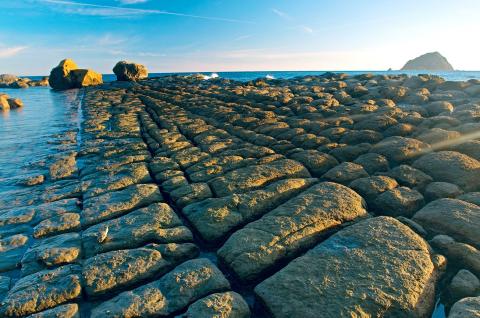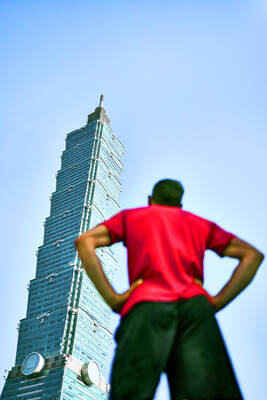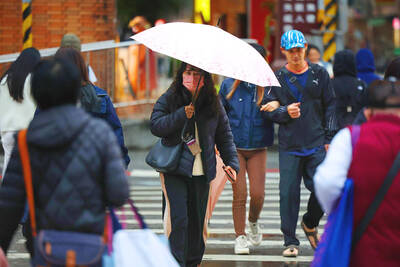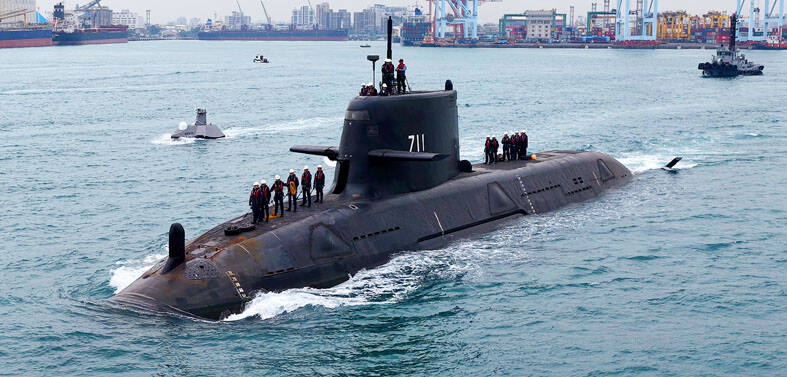The Hoping Island Beach Park, with its vast expanse of “senjojiki” and mushroom-shaped rocks, offers a geological treasure trove for both academics and residents of the Keelung area. However, Keelung locals and environmental groups have said that the park is not being adequately protected, pointing first to a 1,000 ping (3,300m2) wastewater treatment plant that was finished in 2008 and also to an incident in which four junior-high students ruined one of the mushroom-shaped rocks “just for fun” in March this year.
Parts of what is now the park had been under military control for a long time, which meant that people were banned from the area. However, after the ban was gradually lifted in the 1960s and 1970s, more tourists began to explore the vulnerable coastline. Parts of the park were closed for the past three years while renovation work was undertaken and the entirety of the park was opened to the public in June this year.
The “Back Garden,” as locals call the park, is no longer the trash-littered place it once was and the protection of the park has been outsourced to a security and management company.

Photo: CNA, courtesy of Chen Chien-chih.
However, the company’s chief executive, Chen Chien-chih (陳建志), says the firm remains helpless in the face of the damage being done to the park’s unique geological formations and that its employees could do nothing beyond asking tourists not to damage the area, but have no actual powers to stop them.
The island park’s scenery is phenomenal and it is possible to see many geological wonders within the 20-minute round-island hiking trail, Chen said.
The vast expanse of flat square rocks which have been carved into the rocky beachhead resembles thousands of Japanese tatami mats placed on top of one another, which is why the coastal feature has been named senjojiki — literally meaning thousands of tatami mats atop each other, Chen said.
Chen also said seawater has crafted the rocky formations by eroding the tiny joints within the rocks and has, over many years, cut a chessboard-like maze of small squares into the flat rock, resembling chunks of tofu.
Chen said the park affords tourists and visitors a fantastic view of the Keelung coastline, which lies across the strait separating the island from the mainland.
“We plan to build a number of elevated walkways or maybe change the radar stations — which were left over from the period when the island was under military control — into viewing platforms for tourists,” Chen said.
However, Chen said the park lacks infrastructure and other equipment, adding that there was also a shortage of tour guides.
“We need to build a pathway that keeps the tourists from actually touching the ground, something akin to the scenic routes in Yehliu Park — only then can we be certain that we are protecting the park’s geological formations while letting tourists get closer to nature,” he said.
According to Keelung City Government’s Department of Transportation and Tourism, the park is considered “land for park use” and any damage the island suffers must be dealt with as part of the legal framework within Keelung’s Regulations on Park Management and Autonomy (公園自治條例).
However, the punishment for infractions is light and it is difficult to gather evidence, making it hard to effectively stop vandalism within the park, the department added.
Pointing out that Yehliu is now included within the North Coast and Guanyinshan National Scenic Area boundaries, the security and management company charged with protecting the area said that famous scenic sites such as the Queen’s Head Rock Formation (女王頭) enjoys round-the-clock security guards. The Yehliu park has also introduced a system of guard stations to prevent tourists from climbing on and damaging the geological formations within the park, and the guards can fine tourists under the Tourism Development Act (發展觀光條例).
The act stipulates that anyone inflicting irreparable damage to a touristic or scenic spot can be fined as much as NT$5 million (US$167,300).
Despite the setbacks, the department says it is beginning to address the issue, adding that the city government made plans last year to include the park within a city-defined scenic area and to increase management of the park as prescribed under the Development of Tourism Act.
Efforts by lawmakers and civilian representatives to get the park included within the boundaries of the North Coast and Guanyinshan National Scenic Area have also paid off, with the department set to evaluate the request with a decision to be made by the end of the year.
The move has been largely applauded by local residents, who feel that the Hoping Island Beach Park is akin to Yehliu, adding that if the island park is added to the national scenic area, it would bring an increase in tourism and development.
Keelung City Councilor Han Liang-chi (韓良圻) said the most important thing for the city government was to consider how to preserve and protect the “world-class” geological treasure.
“The least we can do is to protect what is left,” Han said.

US climber Alex Honnold is to attempt to scale Taipei 101 without a rope and harness in a live Netflix special on Jan. 24, the streaming platform announced on Wednesday. Accounting for the time difference, the two-hour broadcast of Honnold’s climb, called Skyscraper Live, is to air on Jan. 23 in the US, Netflix said in a statement. Honnold, 40, was the first person ever to free solo climb the 900m El Capitan rock formation in Yosemite National Park — a feat that was recorded and later made into the 2018 documentary film Free Solo. Netflix previewed Skyscraper Live in October, after videos

NUMBERS IMBALANCE: More than 4 million Taiwanese have visited China this year, while only about half a million Chinese have visited here Beijing has yet to respond to Taiwan’s requests for negotiation over matters related to the recovery of cross-strait tourism, the Tourism Administration said yesterday. Taiwan’s tourism authority issued the statement after Chinese-language daily the China Times reported yesterday that the government’s policy of banning group tours to China does not stop Taiwanese from visiting the country. As of October, more than 4.2 million had traveled to China this year, exceeding last year. Beijing estimated the number of Taiwanese tourists in China could reach 4.5 million this year. By contrast, only 500,000 Chinese tourists are expected in Taiwan, the report said. The report

Temperatures are forecast to drop steadily as a continental cold air mass moves across Taiwan, with some areas also likely to see heavy rainfall, the Central Weather Administration (CWA) said. From today through early tomorrow, a cold air mass would keep temperatures low across central and northern Taiwan, and the eastern half of Taiwan proper, with isolated brief showers forecast along Keelung’s north coast, Taipei and New Taipei City’s mountainous areas and eastern Taiwan, it said. Lows of 11°C to 15°C are forecast in central and northern Taiwan, Yilan County, and the outlying Kinmen and Lienchiang (Matsu) counties, and 14°C to 17°C

STEERING FAILURE: The first boat of its class is experiencing teething issues as it readies for acceptance by the navy, according to a recent story about rudder failure The Hai Kun (海鯤), the nation’s first locally built submarine, allegedly suffered a total failure of stern hydraulic systems during the second round of sea acceptance trials on June 26, and sailors were forced to manually operate the X-rudder to turn the submarine and return to port, news Web site Mirror Daily reported yesterday. The report said that tugboats following the Hai Kun assisted the submarine in avoiding collisions with other ships due to the X-rudder malfunctioning. At the time of the report, the submarine had completed its trials and was scheduled to begin diving and surfacing tests in shallow areas. The X-rudder,